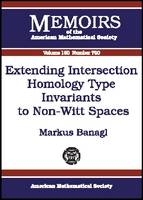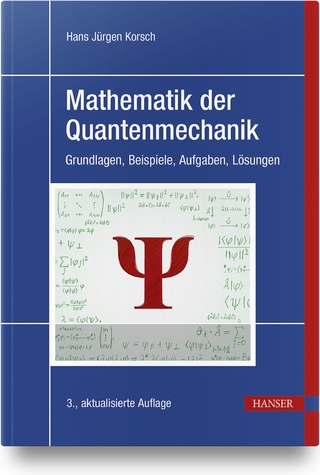
Extending Intersection Homology Type Invariants to Non-Witt Spaces
Seiten
2002
American Mathematical Society (Verlag)
978-0-8218-2988-2 (ISBN)
American Mathematical Society (Verlag)
978-0-8218-2988-2 (ISBN)
- Titel z.Zt. nicht lieferbar
- Versandkostenfrei innerhalb Deutschlands
- Auch auf Rechnung
- Verfügbarkeit in der Filiale vor Ort prüfen
- Artikel merken
Intersection homology theory provides a way to obtain generalized Poincare duality, as well as a signature and characteristic classes, for singular spaces. For this to work, one has to assume however that the space satisfies the so-called Witt condition. We extend this approach to constructing invariants to spaces more general than Witt spaces.
Intersection homology theory provides a way to obtain generalized Poincare duality, as well as a signature and characteristic classes, for singular spaces. For this to work, one has had to assume however that the space satisfies the so-called Witt condition. We extend this approach to constructing invariants to spaces more general than Witt spaces. We present an algebraic framework for extending generalized Poincare duality and intersection homology to singular spaces $X$ not necessarily Witt. The initial step in this program is to define the category $SD(X)$ of complexes of sheaves suitable for studying intersection homology type invariants on non-Witt spaces. The objects in this category can be shown to be the closest possible self-dual 'approximation' to intersection homology sheaves.It is therefore desirable to understand the structure of such self-dual sheaves and to isolate the minimal data necessary to construct them. As the main tool in this analysis we introduce the notion of a Lagrangian structure (related to the familiar notion of Lagrangian submodules for $(-1)^k$-Hermitian forms, as in surgery theory). We demonstrate that every complex in $SD(X)$ has naturally associated Lagrangian structures and conversely, that Lagrangian structures serve as the natural building blocks for objects in $SD(X).Our main result asserts that there is in fact an equivalence of categories between $SD(X)$ and a twisted product of categories of Lagrangian structures. This may be viewed as a Postnikov system for $SD(X)$ whose fibers are categories of Lagrangian structures. The question arises as to which varieties possess Lagrangian structures. To begin to answer that, we define the model-class of varieties with an ordered resolution and use block bundles to describe the geometry of such spaces. Our main result concerning these is that they have associated preferred Lagrangian structures, and hence self-dual generalized intersection homology sheaves.
Intersection homology theory provides a way to obtain generalized Poincare duality, as well as a signature and characteristic classes, for singular spaces. For this to work, one has had to assume however that the space satisfies the so-called Witt condition. We extend this approach to constructing invariants to spaces more general than Witt spaces. We present an algebraic framework for extending generalized Poincare duality and intersection homology to singular spaces $X$ not necessarily Witt. The initial step in this program is to define the category $SD(X)$ of complexes of sheaves suitable for studying intersection homology type invariants on non-Witt spaces. The objects in this category can be shown to be the closest possible self-dual 'approximation' to intersection homology sheaves.It is therefore desirable to understand the structure of such self-dual sheaves and to isolate the minimal data necessary to construct them. As the main tool in this analysis we introduce the notion of a Lagrangian structure (related to the familiar notion of Lagrangian submodules for $(-1)^k$-Hermitian forms, as in surgery theory). We demonstrate that every complex in $SD(X)$ has naturally associated Lagrangian structures and conversely, that Lagrangian structures serve as the natural building blocks for objects in $SD(X).Our main result asserts that there is in fact an equivalence of categories between $SD(X)$ and a twisted product of categories of Lagrangian structures. This may be viewed as a Postnikov system for $SD(X)$ whose fibers are categories of Lagrangian structures. The question arises as to which varieties possess Lagrangian structures. To begin to answer that, we define the model-class of varieties with an ordered resolution and use block bundles to describe the geometry of such spaces. Our main result concerning these is that they have associated preferred Lagrangian structures, and hence self-dual generalized intersection homology sheaves.
Introduction The algebraic framework Ordered resolutions The cobordism group $/Omega_/ast^{SD}$ Lagrangian structures and ordered resolutions Appendix A. On signs Bibliography.
| Erscheint lt. Verlag | 30.9.2002 |
|---|---|
| Reihe/Serie | Memoirs of the American Mathematical Society |
| Verlagsort | Providence |
| Sprache | englisch |
| Gewicht | 198 g |
| Themenwelt | Mathematik / Informatik ► Mathematik ► Analysis |
| Mathematik / Informatik ► Mathematik ► Geometrie / Topologie | |
| ISBN-10 | 0-8218-2988-2 / 0821829882 |
| ISBN-13 | 978-0-8218-2988-2 / 9780821829882 |
| Zustand | Neuware |
| Haben Sie eine Frage zum Produkt? |
Mehr entdecken
aus dem Bereich
aus dem Bereich
Grundlagen, Beispiele, Aufgaben, Lösungen
Buch | Hardcover (2022)
Hanser, Carl (Verlag)
29,99 €


